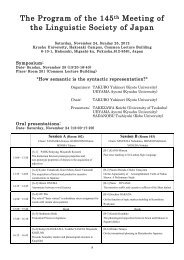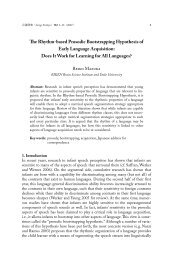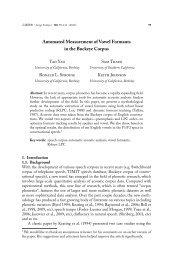第117åæ¥æ¬è§£åå¦ä¼ç·ä¼ã»å ¨å½å¦è¡éä¼ è¬æ¼ããã°ã©ã ã»æé²é PDF ...
第117åæ¥æ¬è§£åå¦ä¼ç·ä¼ã»å ¨å½å¦è¡éä¼ è¬æ¼ããã°ã©ã ã»æé²é PDF ...
第117åæ¥æ¬è§£åå¦ä¼ç·ä¼ã»å ¨å½å¦è¡éä¼ è¬æ¼ããã°ã©ã ã»æé²é PDF ...
Create successful ePaper yourself
Turn your PDF publications into a flip-book with our unique Google optimized e-Paper software.
117 145<br />
P<br />
FIB/SEM <br />
1,3 1 2 2 3 <br />
1<br />
1<br />
2 <br />
3 <br />
<br />
<br />
<br />
<br />
FIB/SEM <br />
CT <br />
8 <br />
5%EDTA<br />
5 1 OsO 4 <br />
EPON812 H7650<br />
FIB/SEM <br />
en block EPON812 <br />
, FIB/SEM <br />
Quanta 3D FEGFEIFIB <br />
Ga 1 nA 80 nm/step<br />
80 μm <br />
<br />
P<br />
Molecular sequence and distribution of the NMDA receptor subunit<br />
NR mRNA in the central nervous system of pigeons Columba livia<br />
Mohammad Rabiul Karim 1,2 , Shouichiro Saito 1 , Yasuro Atoji 1<br />
1<br />
Gifu Univ, Fac Appl Biol Sci, 2 Bangladesh Agri Univ, Fac Vet Sci<br />
NR1 is a key subunit of the NmethylDaspartate type of glutamate receptors<br />
maintaining the glutamatergic system in the mammalian central nervous system<br />
CNS. In the present study, cDNA sequence and expression pattern of NR1<br />
mRNA in the pigeon CNS were examined. From cDNA sequence analysis, its<br />
predicted amino acid sequence was revealed to show 96%, 95% and 85% identity<br />
to that of the chicken, zebra finch and human NR1, respectively. By RTPCR,<br />
pigeon NR1 mRNA was revealed to be highlevel in the olfactory bulb, pallium<br />
and subpallium of the telencephalon and in the cerebellum, mediumlevel in the<br />
diencephalon and optic tectum, and lowlevel in the lower brainstem and spinal<br />
cord. By in situ hybridization, intense hybridization signal was observed in the<br />
olfactory bulb, pallium except entopallium, septal nuclei and striatum of the<br />
telencephalon, and the granular and Purkinje cell layers of the cerebellum, and<br />
weak signal in the thalamus, optic tectum, lower brain stem and gray matter of<br />
the spinal cord. This study revealed the similarity of NR1 expression between the<br />
pigeon and mammals, indicating the functional importance of the glutamatergic<br />
system in the avian CNS.<br />
P<br />
<br />
<br />
<br />
<br />
<br />
<br />
2 VGLUT2mRNA <br />
VGLUT2 <br />
<br />
<br />
0.1% 4<br />
50 μm VGLUT2 C <br />
<br />
<br />
<br />
HVC, RA, area X <br />
<br />
MC,<br />
An, NL , MC <br />
VGLUT2mRNA <br />
<br />
<br />
P<br />
SULTBa <br />
<br />
<br />
<br />
<br />
<br />
<br />
GABA A<br />
GABA <br />
<br />
SULT2A1 SULT2B1a <br />
mRNA<br />
<br />
<br />
SULT2B1a SULT2B1a <br />
SULT2B1a <br />
<br />
SULT2B1a <br />
<br />
P<br />
<br />
<br />
<br />
DGDGK<br />
C DG <br />
DGK DGK<br />
DGKε DG <br />
DGKε <br />
DGKε <br />
DGKε <br />
64 kDa <br />
<br />
DGKε <br />
DGKε 1 <br />
IP3R1<br />
DGKε <br />
IP3R1 <br />
P<br />
Androgen receptor expression in the preoptic and anterior<br />
hypothalamic areas of the adult male rats and mice<br />
Jahan Mir Rubayet, Keiji Kokubu, Chikahisa Matsuo, Islam Md. Nabiul,<br />
Akie Yanai, Ryutaro Fujinaga, Koh Shinoda<br />
Functional Neuroanatomy, Yamaguchi Univ. Grad. Sch. of Med.<br />
Species difference has been suggested on androgeninduced functions of the<br />
preoptic and anterior hypothalamic areas PO/AH. Using paraformaldehyde<br />
fixed completely serial frozen sections, expression of androgen receptor AR was<br />
immunohistochemically compared in the PO/AH between adult male rats Wistar,<br />
SD and mice C57BL/6, DBA/2j, Balb/c. In general, AR expression was stronger<br />
in mice than rats, particularly in the medial preoptic area MPO, posterodorsal<br />
preoptic nucleus, dorsal PO/AH junction DPAJ and suprachiasmatic nucleus<br />
SCN. Exceptionally, more ARimmunoreactive ARir cells were seen in the<br />
sexually dimorphic nucleus SDN of the MPO and periventricular zone of the AH<br />
in rats. In addition, we found a distinct mousespecific ARir neuronal cluster as<br />
the “tear drop nucleus (TDN)” dorsal to the SCN, which resembles the rat SDN or<br />
mouse putative SDN in calbindin immunoreactivity, and two distinct ratspecific<br />
small clusters as the “DPAJ island” and “paraventricular island”. The present data<br />
might explain distinct androgeninduced psychotic, behavioral and endocrinergic<br />
responses between the two rodents, warning that data cannot directly be applied<br />
each other.







